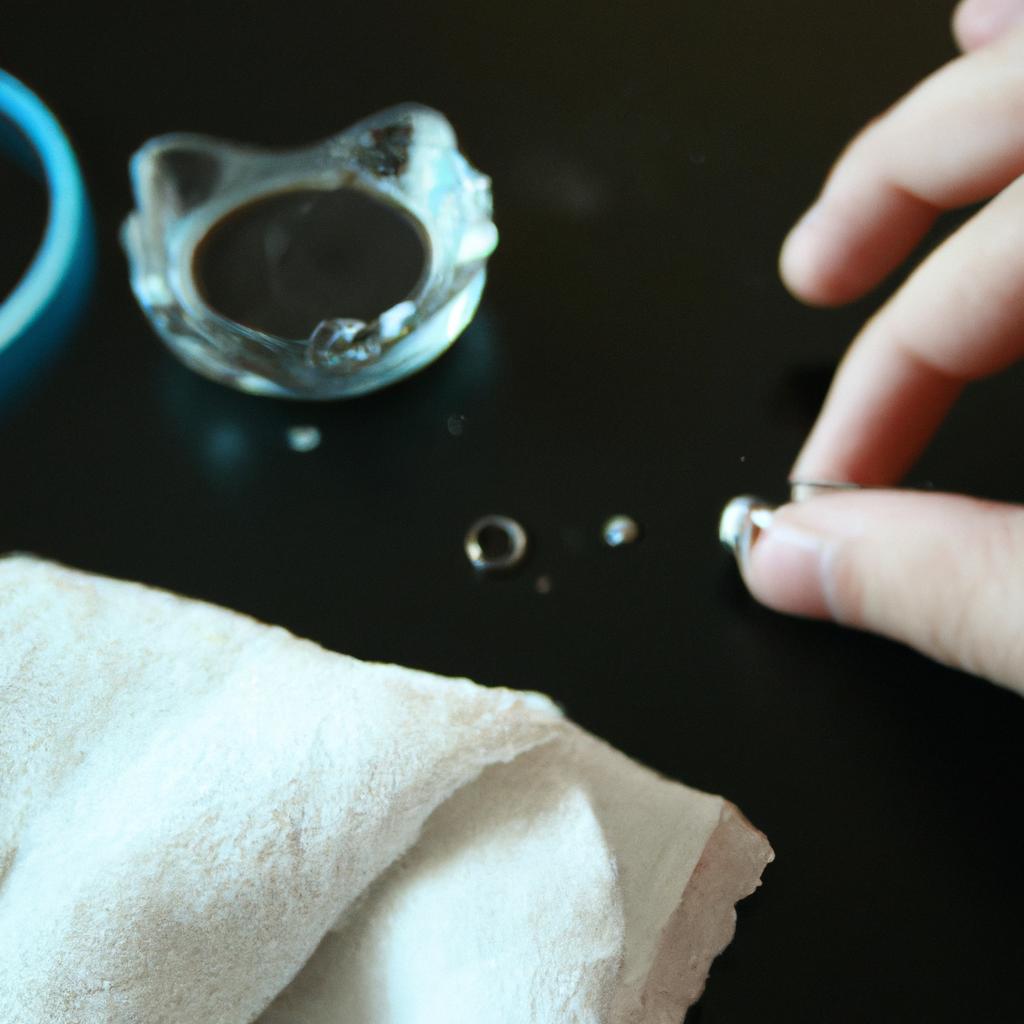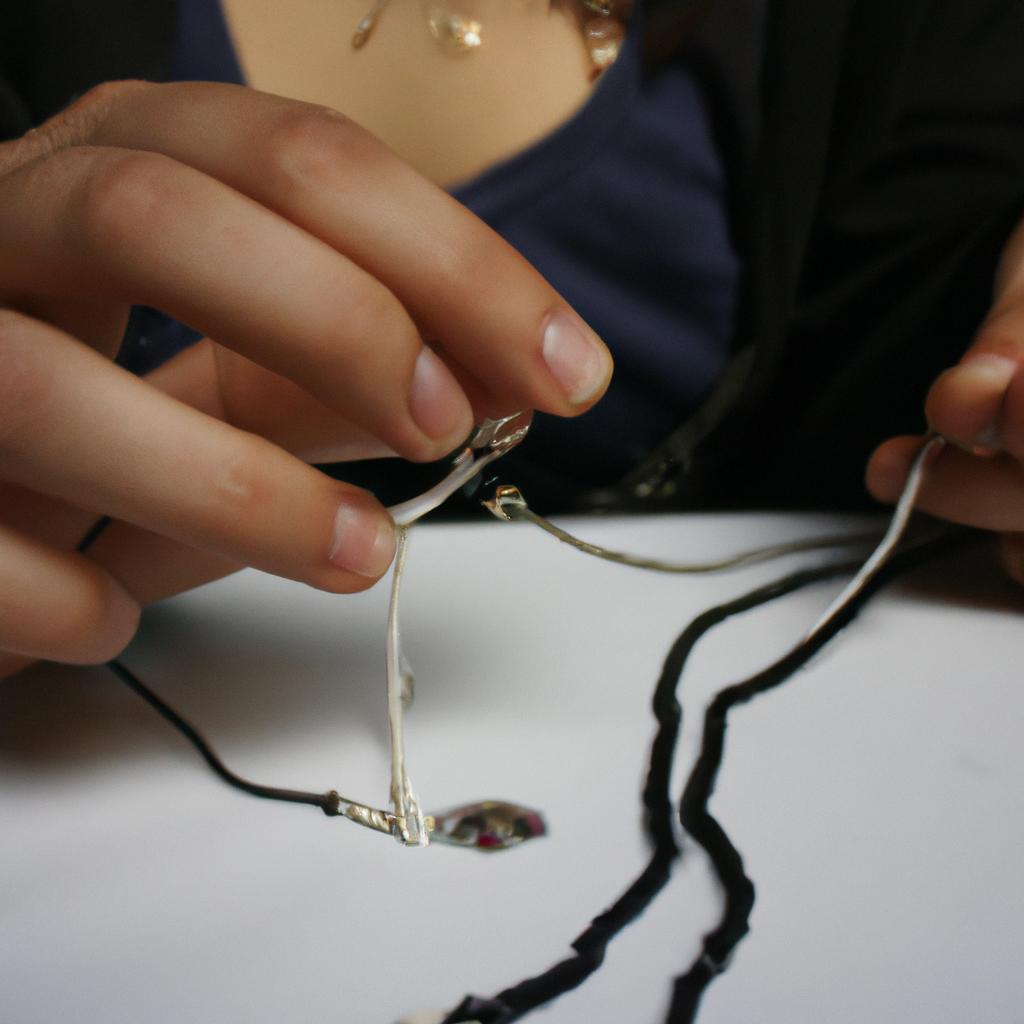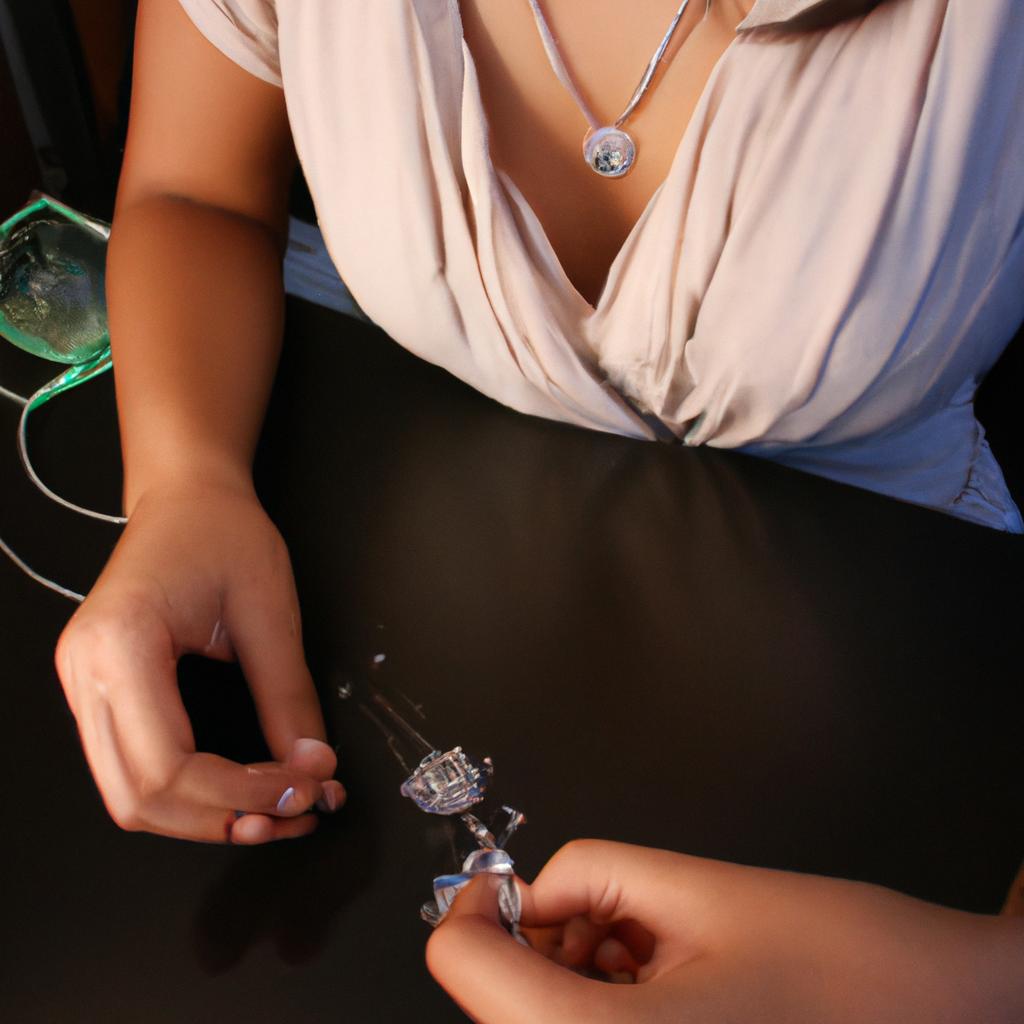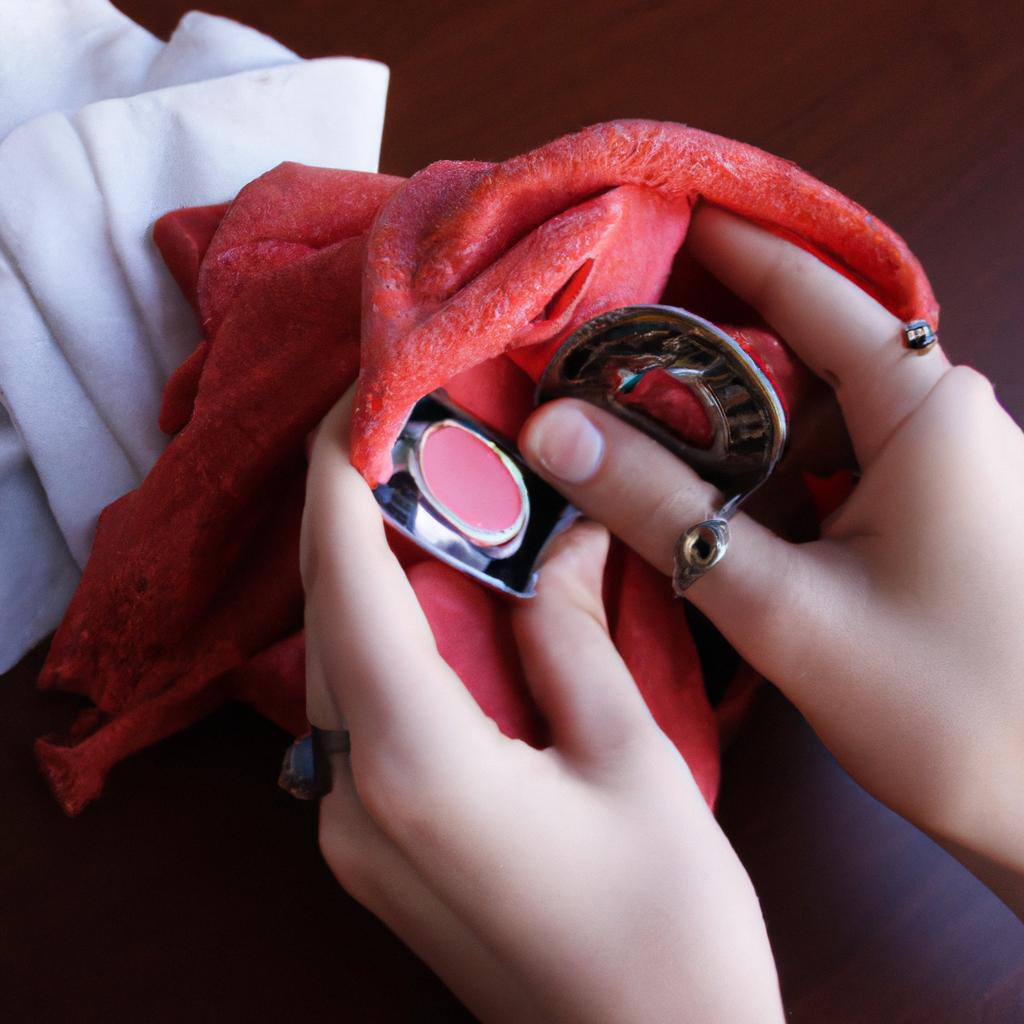Over time, jewelry can lose its luster and shine due to natural wear and tear. One common way to restore the beauty of jewelry is through polishing techniques. Polishing involves the removal of scratches, tarnish, and dullness on various types of jewelry, including gold, silver, and gemstones. This article explores different effective polishing techniques that enhance jewelry care.
Consider a scenario where a cherished family heirloom—a vintage diamond necklace—has lost its brilliance over the years. The once dazzling diamonds are now obscured by scratches and a layer of grime. In such cases, proper polishing techniques can breathe new life into the piece, restoring it to its former glory. By understanding the different methods available for jewelry polishing and learning how to apply them correctly, individuals can ensure their precious ornaments remain radiant and exquisite for generations to come.
Polishing plays a crucial role in maintaining the aesthetic appeal of jewelry while also preserving its value. However, it requires knowledge about suitable materials and techniques to prevent any further damage or deterioration during the process. Consequently, this article will delve into several tried-and-tested methods utilized by professionals in the field of jewelry care. From traditional hand-polishing using specialized cloths to modern ultrasonic cleaning machines capable of removing stubborn dirt particles, each method has its own unique benefits and considerations.
One of the most common and accessible methods for polishing jewelry is using a jewelry polishing cloth. These cloths are typically made of soft, non-abrasive materials that are specially designed to remove tarnish and restore shine without scratching the surface of the jewelry. To use a polishing cloth, simply rub the surface of the jewelry gently in a back-and-forth motion until desired results are achieved.
Another popular technique for polishing jewelry is using a jewelry cleaning solution or paste. These solutions often contain mild abrasives that help to remove dirt, grime, and tarnish from the surface of the jewelry. To use a cleaning solution or paste, apply a small amount to a soft cloth or brush and gently scrub the jewelry in circular motions. Be sure to rinse thoroughly with water after cleaning to remove any residue.
For more intricate pieces or those with hard-to-reach areas, an ultrasonic cleaner can be an effective option. Ultrasonic cleaners use high-frequency sound waves to create tiny bubbles that gently lift dirt and debris from the surface of the jewelry. Simply place the jewelry in a basket or tray within the cleaner, add water and any recommended cleaning solution, then turn on the machine for a specified amount of time.
In addition to these methods, there are also professional services available for more extensive polishing needs. Jewelers often have access to specialized equipment such as rotary tumblers or steam cleaners that can provide deep cleaning and restoration for heavily tarnished or damaged pieces. This may be particularly useful for antique or delicate items where extra care is required.
It’s important to note that not all types of jewelry can be polished using these methods. Some gemstones, such as pearls and opals, are delicate and require specialized care. Additionally, certain finishes like oxidized silver or patinaed metals should not be polished as it may alter their intended appearance.
In conclusion, understanding different polishing techniques can help individuals maintain the beauty and value of their jewelry. Whether using a simple polishing cloth, a cleaning solution, or seeking professional services, proper care and maintenance can ensure that cherished pieces continue to shine for years to come.
Choosing the Right Polishing Cloth
Imagine you have just inherited a beautiful antique necklace with intricate details and exquisite gemstones. It has been passed down through generations, carrying sentimental value along with its stunning craftsmanship. However, over time, it has lost some of its luster due to exposure to natural elements and regular wear. To restore its former glory and preserve its beauty for future generations, proper polishing is essential. One crucial aspect of jewelry care is selecting the right polishing cloth.
When choosing a polishing cloth, there are several factors to consider. Firstly, opt for a soft cloth made from non-abrasive materials such as microfiber or flannel. These fabrics ensure that the surface of your jewelry remains unharmed during the cleaning process. Avoid using rough or abrasive cloths as they can create scratches on delicate surfaces or cause damage to gemstones.
Secondly, pay attention to the size of the cloth. A larger cloth provides more coverage area while allowing you to maintain a firm grip during the polishing process. This ensures that every nook and cranny of your jewelry receives equal attention without compromising your comfort or safety.
Furthermore, look for a lint-free cloth that doesn’t leave behind any residue or fibers on your jewelry after cleaning. Lint can get trapped in crevices and diminish the shine of your pieces, requiring additional effort to remove them completely.
To summarize these key points:
- Choose a soft cloth made from non-abrasive materials.
- Opt for a larger-sized cloth for better coverage and grip.
- Select a lint-free cloth that leaves no residue behind.
- Ensure durability by picking high-quality options.
By carefully considering these factors when selecting a suitable polishing cloth, you ensure effective and safe cleaning practices for your precious jewelry collection.
Understanding the Different Types of Polishing Compounds
Having explored how to choose an appropriate polishing cloth, let’s now delve into understanding the various types of polishing compounds available in the market.
Understanding the Different Types of Polishing Compounds
Enhancing the beauty of jewelry requires not only choosing the right polishing cloth but also understanding the different types of polishing compounds. By utilizing these techniques, you can ensure that your jewelry shines and remains in excellent condition for years to come.
Imagine a scenario where a customer brings in a tarnished silver necklace with intricate detailing. The tarnish has diminished its luster and overall appeal. However, by employing proper polishing techniques, you can restore the brilliance of this piece and leave the customer delighted with their rejuvenated jewelry.
To achieve optimal results when using a polishing cloth, consider the following:
- Use gentle yet firm pressure while rubbing the cloth against the surface of the jewelry.
- Ensure that each stroke is consistent and in one direction to avoid creating additional scratches.
- Pay extra attention to hard-to-reach areas or crevices where dirt or tarnish tends to accumulate.
- Regularly inspect the cloth for signs of wear or accumulation of debris, as this may hinder its effectiveness over time.
In addition to using a high-quality polishing cloth, it is crucial to select an appropriate polishing compound based on your specific needs. Polishing compounds are available in various forms such as powders, pastes, or creams. Consider factors such as metal type, desired level of shine, and any existing coatings before selecting a suitable compound. Referencing specialized guides or seeking professional advice from jewelers can assist you in making informed decisions regarding which compound will best suit your requirements.
By carefully considering both your choice of polishing cloth and understanding various types of polishing compounds, you can effectively enhance the appearance and longevity of your jewelry collection. In our next section on “Applying Polishing Compounds Correctly,” we will delve deeper into application methods to further refine your skills in maintaining exquisite pieces.
Emotional Bullet Point List
The process of enhancing jewelry care through proper polishing techniques evokes several emotions among enthusiasts:
- Satisfaction: Witnessing dull jewelry transform into a radiant piece brings a sense of accomplishment.
- Appreciation: Understanding the intricate details and craftsmanship becomes more apparent when jewelry is well-maintained.
- Confidence: Knowing that your jewelry collection always looks its best boosts self-assurance and personal style.
- Longevity: Preserving the quality of cherished pieces ensures they can be enjoyed by future generations, fostering sentimental value.
| Emotions | Associated Actions |
|---|---|
| Satisfaction | Admiring the transformed shine |
| Appreciation | Noticing previously unnoticed intricacies |
| Confidence | Wearing with pride and elegance |
| Longevity | Passing down as heirlooms |
As we explore techniques for applying polishing compounds correctly in the next section, you will gain further insights to refine your skills and elevate your ability to maintain exquisite jewelry.
Applying Polishing Compounds Correctly
In the previous section, we explored the various types of polishing compounds commonly used in jewelry care. Now, let’s delve deeper into how these compounds are applied correctly to achieve optimal results.
To illustrate this process, let’s consider a hypothetical scenario involving an antique silver necklace with tarnished surfaces and dull appearance. To restore its former luster, it is crucial to select the appropriate polishing compound based on the metal type and desired outcome.
When applying polishing compounds, there are several key factors to keep in mind:
-
Compound Consistency: The consistency of the compound plays a significant role in achieving effective results. Depending on the task at hand, choose between liquid or solid forms of compounds for different levels of abrasiveness and ease of application.
-
Proper Application Technique: Applying too much pressure during polishing can cause scratches or damage to delicate jewelry pieces. It is essential to use gentle, circular motions while evenly distributing the compound over the surface area being polished.
-
Time and Frequency: The duration and frequency of polishing depend on various factors such as the level of tarnish or wear present on the piece. Regular maintenance prevents excessive tarnish buildup and reduces the need for intense polishing sessions.
-
Safety Precautions: Always ensure adequate ventilation when working with polishing compounds, especially those containing chemicals that may emit fumes or have potential health hazards. Additionally, wearing protective gloves and eyewear can prevent any adverse reactions from exposure to certain compounds.
Consider this table highlighting popular types of polishing compounds for different metals:
| Metal Type | Recommended Polishing Compound |
|---|---|
| Silver | Rouge |
| Gold | Tripoli |
| Stainless Steel | White Diamond |
By understanding these considerations and selecting suitable compounds accordingly, you can effectively enhance your jewelry’s appearance while preserving its integrity.
Transitioning smoothly into our next section about “Using the Proper Polishing Technique,” we will explore the step-by-step process of polishing jewelry, ensuring a professional finish that showcases its true beauty.
Using the Proper Polishing Technique
Enhancing the beauty of jewelry requires not only applying polishing compounds correctly but also using the proper polishing technique. By combining these two elements, jewelers can achieve stunning results that will captivate any observer. In this section, we will explore various techniques that can be employed to enhance jewelry care and ensure a flawless finish.
Imagine a scenario where a jeweler is tasked with restoring an antique diamond ring. The ring has lost its luster over time and needs careful attention to bring back its original shine. The jeweler begins by selecting the appropriate polishing compound based on the type of metal used in the ring. This ensures that the abrasive properties of the compound are suitable for the specific material being polished. For example, if the ring is made of gold, a compound designed for gold should be utilized.
To effectively use the selected polishing compound, it is crucial to employ consistent pressure during the polishing process. Applying excessive force may result in uneven surfaces or even damage delicate settings. Conversely, insufficient pressure might lead to incomplete removal of scratches or tarnish. By maintaining steady and controlled pressure while moving in circular motions across the surface of the jewelry piece, jewelers can eliminate imperfections and restore its brilliance.
Here are some key considerations when using proper polishing techniques:
- Always use clean and lint-free cloths to avoid leaving behind unwanted particles.
- Pay attention to speed: too fast may cause overheating, while too slow might prolong the process unnecessarily.
- Regularly inspect your progress under good lighting conditions to identify areas that require additional attention.
- Take breaks between longer sessions to prevent fatigue and maintain focus throughout each stage of polishing.
Table: Common Polishing Techniques
| Technique | Description | Benefits |
|---|---|---|
| Circular | Moving in circular motions around a fixed point | Effective at removing light scratches |
| Figure Eight | Creating figure-eight patterns while applying gentle force | Achieves a uniform finish on curved surfaces |
| Back and Forth | Polishing back and forth in straight lines | Ideal for removing deeper scratches or stubborn tarnish |
| Random Movement | Employing random motions to cover the entire surface evenly | Provides an even polish without leaving visible tool marks |
Incorporating these techniques into jewelry care can significantly enhance the final result, restoring its original beauty and allure. By carefully selecting appropriate polishing compounds and utilizing proper techniques such as circular, figure-eight, back and forth, or random movement, jewelers can achieve remarkable outcomes that will leave clients delighted with their restored pieces.
Transitioning seamlessly from enhancing jewelry care through proper polishing techniques, we will now delve into avoiding common mistakes in jewelry polishing. Understanding what pitfalls to avoid is equally important to ensure the best possible outcome when working with delicate and valuable items.
Avoiding Common Mistakes in Jewelry Polishing
Enhancing the Shine: Selecting the Right Polishing Technique
Imagine this scenario: You have a beautiful diamond necklace that has lost its luster over time. You want to restore its brilliance and shine, but you’re unsure which polishing technique would be best suited for this delicate piece of jewelry. Choosing the proper method is crucial in order to avoid any potential damage or scratches. In this section, we will explore some effective techniques and considerations when it comes to polishing your precious jewelry.
When deciding on the appropriate polishing technique for your jewelry, there are several factors to take into account. Firstly, consider the type of metal used in your piece – whether it’s gold, silver, platinum, or another material. Different metals require different approaches to achieve optimal results without causing harm. Secondly, examine the condition of the item; if there are deep scratches or tarnish present, additional steps may be necessary before proceeding with regular polishing methods.
To guide you further in selecting the right approach for enhancing your jewelry’s shine and overall appearance, here are some key considerations:
- The intricacy of design: Delicate pieces with intricate designs may require more specialized care.
- Gemstone settings: Jewelry adorned with gemstones should be handled differently than those without.
- Antique or vintage pieces: Older items often necessitate gentler techniques due to their age and potential fragility.
- Surface finish: Smooth surfaces versus textured finishes may call for varying methods to achieve desired results.
In addition to these helpful tips, referring to a comprehensive table can provide an overview of various suitable techniques based on common scenarios encountered during jewelry maintenance:
| Scenario | Suitable Polishing Technique |
|---|---|
| Tarnished silver | Silver polish or microfiber cloth |
| Scratched gold bracelet | Professional buffing service or mild abrasive paste |
| Dull platinum engagement ring | Gentle brushing using warm soapy water |
| Oxidized copper earrings | Lemon juice and salt solution |
By considering these factors and consulting the accompanying table, you can make informed decisions to ensure your jewelry receives the proper care it deserves.
Transitioning smoothly into the next section about “Tips for Maintaining the Shine and Luster of Your Jewelry,” it is essential to continue exploring additional aspects that contribute to preserving the beauty of your cherished pieces. By incorporating effective maintenance practices into your routine, you can prolong their shine and luster while reducing potential damage or deterioration over time.
Tips for Maintaining the Shine and Luster of Your Jewelry
Enhancing the Shine and Luster of Your Jewelry
Having learned about common mistakes to avoid in jewelry polishing, we can now focus on tips for maintaining the shine and luster of your precious pieces. Let’s consider a hypothetical scenario involving a cherished diamond necklace passed down through generations. This will help us understand how proper care and polishing techniques play a crucial role in preserving the beauty of our jewelry.
To begin with, it is essential to handle your jewelry with care during cleaning and everyday wear. Avoid exposing it to harsh chemicals or abrasive materials that may cause damage. When storing your jewelry, keep it separate from other pieces to prevent scratches. Additionally, regularly inspecting your items for loose stones or clasps can help you address any problems promptly.
Here are some key strategies to enhance the longevity and allure of your jewelry:
-
Regular Cleaning: Clean your jewelry periodically using appropriate methods depending on the type of metal and gemstone involved. Use gentle cleansers specifically designed for delicate jewelry, avoiding strong detergents that might harm the piece.
-
Polishing Techniques: Employ suitable polishing tools such as soft microfiber cloths or special jewelry polishing creams to restore shine while being mindful not to over-polish, which could lead to loss of detail or surface erosion.
-
Professional Maintenance: Consider seeking professional assistance once in a while for deep cleaning and inspection by experienced jewelers who can identify potential issues early on and suggest necessary repairs or adjustments.
-
Proper Storage: Store each piece separately in fabric-lined compartments or individual pouches to protect them from scratching against one another or coming into contact with air moisture, preventing tarnishing.
Now let’s delve deeper into these strategies through a table outlining their benefits:
| Strategy | Benefits |
|---|---|
| Regular Cleaning | – Removes dirt and oils accumulated from daily wear |
| – Restores brilliance and sparkle | |
| – Prevents buildup of residues that might dull the surface | |
| Polishing Techniques | – Revives shine and luster |
| – Maintains intricate details | |
| Professional Maintenance | – Ensures thorough cleaning and examination |
| – Detects early signs of damage or wear | |
| Proper Storage | – Reduces risk of scratching or tangling |
| – Minimizes exposure to air, preventing tarnish |
By implementing these strategies in your jewelry care routine, you can preserve the beauty and value of your precious pieces for years to come. Remember, maintaining the shine and luster requires consistent effort and attention but is well worth it when admiring the radiance of your cherished jewelry.
 Shanes Jewelry
Shanes Jewelry



